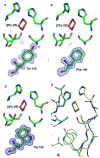Atomic resolution structures of rieske iron-sulfur protein: role of hydrogen bonds in tuning the redox potential of iron-sulfur clusters
- PMID: 17223530
- PMCID: PMC1868424
- DOI: 10.1016/j.str.2006.11.012
Atomic resolution structures of rieske iron-sulfur protein: role of hydrogen bonds in tuning the redox potential of iron-sulfur clusters
Abstract
The Rieske [2Fe-2S] iron-sulfur protein of cytochrome bc(1) functions as the initial electron acceptor in the rate-limiting step of the catalytic reaction. Prior studies have established roles for a number of conserved residues that hydrogen bond to ligands of the [2Fe-2S] cluster. We have constructed site-specific variants at two of these residues, measured their thermodynamic and functional properties, and determined atomic resolution X-ray crystal structures for the native protein at 1.2 A resolution and for five variants (Ser-154-->Ala, Ser-154-->Thr, Ser-154-->Cys, Tyr-156-->Phe, and Tyr-156-->Trp) to resolutions between 1.5 A and 1.1 A. These structures and complementary biophysical data provide a molecular framework for understanding the role hydrogen bonds to the cluster play in tuning thermodynamic properties, and hence the rate of this bioenergetic reaction. These studies provide a detailed structure-function dissection of the role of hydrogen bonds in tuning the redox potentials of [2Fe-2S] clusters.
Conflict of interest statement
Figures



Similar articles
-
Resonance Raman characterization of archaeal and bacterial Rieske protein variants with modified hydrogen bond network around the [2Fe-2S] center.Protein Sci. 2006 Aug;15(8):2019-24. doi: 10.1110/ps.052035406. Protein Sci. 2006. PMID: 16877714 Free PMC article.
-
Roles of the disulfide bond and adjacent residues in determining the reduction potentials and stabilities of respiratory-type Rieske clusters.Biochemistry. 2005 May 10;44(18):7048-58. doi: 10.1021/bi050189x. Biochemistry. 2005. PMID: 15865449
-
Potential ligands to the [2Fe-2S] Rieske cluster of the cytochrome bc1 complex of Rhodobacter capsulatus probed by site-directed mutagenesis.Biochemistry. 1992 Apr 7;31(13):3342-51. doi: 10.1021/bi00128a006. Biochemistry. 1992. PMID: 1313292
-
Structure and function of the bacterial bc1 complex: domain movement, subunit interactions, and emerging rationale engineering attempts.J Bioenerg Biomembr. 1999 Jun;31(3):275-88. doi: 10.1023/a:1005428014548. J Bioenerg Biomembr. 1999. PMID: 10591533 Review.
-
Structure and electrochemistry of proteins harboring iron-sulfur clusters of different nuclearities. Part I. [4Fe-4S]+[2Fe-2S] iron-sulfur proteins.J Struct Biol. 2017 Oct;200(1):1-19. doi: 10.1016/j.jsb.2017.05.010. Epub 2017 Jun 13. J Struct Biol. 2017. PMID: 28619651 Review.
Cited by
-
Loss of a conserved tyrosine residue of cytochrome b induces reactive oxygen species production by cytochrome bc1.J Biol Chem. 2011 May 20;286(20):18139-48. doi: 10.1074/jbc.M110.214460. Epub 2011 Mar 23. J Biol Chem. 2011. PMID: 21454570 Free PMC article.
-
The small subunit AroB of arsenite oxidase: lessons on the [2Fe-2S] Rieske protein superfamily.J Biol Chem. 2010 Jul 2;285(27):20442-51. doi: 10.1074/jbc.M110.113811. Epub 2010 Apr 26. J Biol Chem. 2010. PMID: 20421651 Free PMC article.
-
Effect of H bond removal and changes in the position of the iron-sulphur head domain on the spin-lattice relaxation properties of the [2Fe-2S](2+) Rieske cluster in cytochrome bc(1).Phys Chem Chem Phys. 2015 Oct 14;17(38):25297-308. doi: 10.1039/c5cp02815a. Phys Chem Chem Phys. 2015. PMID: 26355649 Free PMC article.
-
Sodium sulfide selectively induces oxidative stress, DNA damage, and mitochondrial dysfunction and radiosensitizes glioblastoma (GBM) cells.Redox Biol. 2019 Sep;26:101220. doi: 10.1016/j.redox.2019.101220. Epub 2019 May 16. Redox Biol. 2019. PMID: 31176262 Free PMC article.
-
The CATH classification revisited--architectures reviewed and new ways to characterize structural divergence in superfamilies.Nucleic Acids Res. 2009 Jan;37(Database issue):D310-4. doi: 10.1093/nar/gkn877. Epub 2008 Nov 7. Nucleic Acids Res. 2009. PMID: 18996897 Free PMC article.
References
-
- Backes G, Mino Y, Loehr TM, Meyer TE, Cusanovich MA, Sweeney WV, Adman ET, Sanders-Loefr J. Environment of Fe4S4 clusters in ferredoxins and high-potential iron proteins. New information from x-ray crystallography and resonance Raman spectroscopy. J Am Chem Soc. 1991;113:2055–2064.
-
- Bard AJ, Faulkner LR. Electrochemical Methods. 2. New York: Wiley; 2001.
-
- Berry EA, Guergova-Kuras M, Huang LS, Crofts AR. Structure and function of cytochrome bc complexes. Annu Rev Biochem. 2000;69:1005–1075. - PubMed
-
- Bonisch H, Schmidt CL, Schafer G, Ladenstein R. The structure of the soluble domain of an archaeal Rieske iron-sulfur protein at 1.1 A resolution. J Mol Biol. 2002;319:791–805. - PubMed
Publication types
MeSH terms
Substances
Grants and funding
LinkOut - more resources
Full Text Sources

